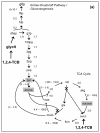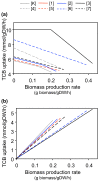In silico feasibility of novel biodegradation pathways for 1,2,4-trichlorobenzene
- PMID: 20122273
- PMCID: PMC2830930
- DOI: 10.1186/1752-0509-4-7
In silico feasibility of novel biodegradation pathways for 1,2,4-trichlorobenzene
Abstract
Background: Bioremediation offers a promising pollution treatment method in the reduction and elimination of man-made compounds in the environment. Computational tools to predict novel biodegradation pathways for pollutants allow one to explore the capabilities of microorganisms in cleaning up the environment. However, given the wealth of novel pathways obtained using these prediction methods, it is necessary to evaluate their relative feasibility, particularly within the context of the cellular environment.
Results: We have utilized a computational framework called BNICE to generate novel biodegradation routes for 1,2,4-trichlorobenzene (1,2,4-TCB) and incorporated the pathways into a metabolic model for Pseudomonas putida. We studied the cellular feasibility of the pathways by applying metabolic flux analysis (MFA) and thermodynamic constraints. We found that the novel pathways generated by BNICE enabled the cell to produce more biomass than the known pathway. Evaluation of the flux distribution profiles revealed that several properties influenced biomass production: 1) reducing power required, 2) reactions required to generate biomass precursors, 3) oxygen utilization, and 4) thermodynamic topology of the pathway. Based on pathway analysis, MFA, and thermodynamic properties, we identified several promising pathways that can be engineered into a host organism to accomplish bioremediation.
Conclusions: This work was aimed at understanding how novel biodegradation pathways influence the existing metabolism of a host organism. We have identified attractive targets for metabolic engineers interested in constructing a microorganism that can be used for bioremediation. Through this work, computational tools are shown to be useful in the design and evaluation of novel xenobiotic biodegradation pathways, identifying cellularly feasible degradation routes.
Figures




Similar articles
-
Computational framework for predictive biodegradation.Biotechnol Bioeng. 2009 Dec 15;104(6):1086-97. doi: 10.1002/bit.22489. Biotechnol Bioeng. 2009. PMID: 19650084 Free PMC article.
-
Thermodynamic analysis of biodegradation pathways.Biotechnol Bioeng. 2009 Jun 15;103(3):532-41. doi: 10.1002/bit.22285. Biotechnol Bioeng. 2009. PMID: 19288443 Free PMC article.
-
Trends in predictive biodegradation for sustainable mitigation of environmental pollutants: Recent progress and future outlook.Sci Total Environ. 2021 May 20;770:144561. doi: 10.1016/j.scitotenv.2020.144561. Epub 2021 Jan 17. Sci Total Environ. 2021. PMID: 33736422 Review.
-
Biodegradation of 3-chlorobenzoic acid with electron shuttle systems: pathways and molecular identification.Arch Microbiol. 2020 Nov;202(9):2471-2480. doi: 10.1007/s00203-020-01965-1. Epub 2020 Jul 1. Arch Microbiol. 2020. PMID: 32613418
-
The logicome of environmental bacteria: merging catabolic and regulatory events with Boolean formalisms.Environ Microbiol. 2011 Sep;13(9):2389-402. doi: 10.1111/j.1462-2920.2011.02455.x. Epub 2011 Mar 16. Environ Microbiol. 2011. PMID: 21410625 Review.
Cited by
-
Wheat phyllosphere yeasts degrade propiconazole.BMC Microbiol. 2020 Aug 5;20(1):242. doi: 10.1186/s12866-020-01885-6. BMC Microbiol. 2020. PMID: 32758148 Free PMC article.
-
A review of metabolic and enzymatic engineering strategies for designing and optimizing performance of microbial cell factories.Comput Struct Biotechnol J. 2014 Sep 3;11(18):91-9. doi: 10.1016/j.csbj.2014.08.010. eCollection 2014 Aug. Comput Struct Biotechnol J. 2014. PMID: 25379147 Free PMC article. Review.
-
Perspectives of Microbial Inoculation for Sustainable Development and Environmental Management.Front Microbiol. 2018 Dec 5;9:2992. doi: 10.3389/fmicb.2018.02992. eCollection 2018. Front Microbiol. 2018. PMID: 30568644 Free PMC article. Review.
-
Microbial biofilm ecology, in silico study of quorum sensing receptor-ligand interactions and biofilm mediated bioremediation.Arch Microbiol. 2021 Jan;203(1):13-30. doi: 10.1007/s00203-020-02012-9. Epub 2020 Aug 12. Arch Microbiol. 2021. PMID: 32785735 Review.
-
Pesticide degradation capacity of a novel strain belonging to Serratia sarumanii with its genomic profile.Biodegradation. 2025 Jun 1;36(3):49. doi: 10.1007/s10532-025-10144-2. Biodegradation. 2025. PMID: 40451994 Free PMC article.
References
-
- Jain RK, Kapur M, Labana S, Lal B, PM S, Bhattacharya D, Thakur IS. Microbial diversity: application of microorganisms for the biodegradation of xenobiotics. Curr Sci. 2005;89:101–112.
-
- Meer JR van der. In: Microbial biodegradation: Genomics and molecular biology. Diaz E, editor. Norfolk, UK: Caister Academic Press; 2008. A genomic view on the evolution of catabolic pathways and bacterial adaptation to xenobiotic compounds.
Publication types
MeSH terms
Substances
LinkOut - more resources
Full Text Sources

